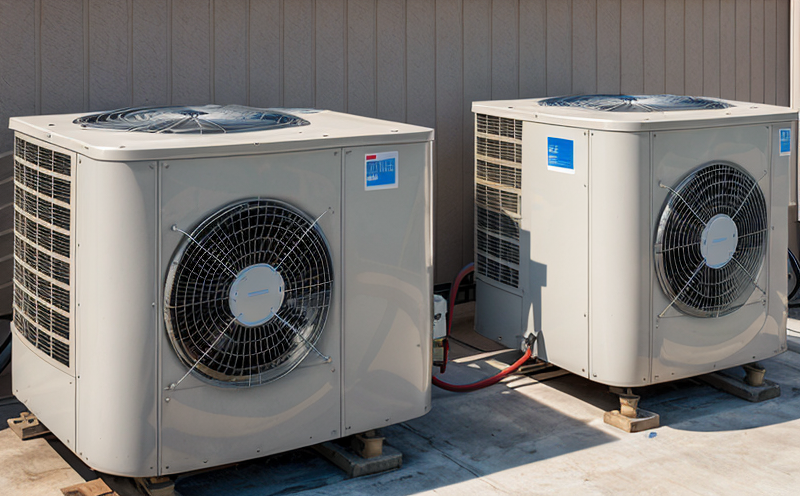ASHRAE Guideline 36-2 Advanced Control Sequence Testing
The ASHRAE Guideline 36-2 is a comprehensive document that provides recommendations for the design, installation, and commissioning of control systems for HVAC equipment. This guideline ensures that all critical aspects of HVAC control sequences are considered to optimize system performance, energy efficiency, and occupant comfort while maintaining compliance with relevant standards.
The Advanced Control Sequence Testing service focuses on ensuring that your HVAC control systems meet the stringent requirements set forth in ASHRAE Guideline 36-2. Our experienced team utilizes state-of-the-art testing equipment to simulate real-world operating conditions, thereby verifying that each component of the system operates as intended and contributes effectively towards achieving optimal performance.
Our testing process begins with a thorough review of your HVAC control sequence documentation against ASHRAE Guideline 36-2 requirements. This initial step ensures we understand exactly what needs to be tested before proceeding further. Following this, our lab technicians will conduct detailed simulations under various operating conditions to assess how well each part interacts within the overall system.
Testing is conducted using specialized tools that replicate actual field environments where possible. We employ sophisticated software packages capable of modeling complex interactions between different elements of an HVAC setup. By doing so, we can identify potential issues early on in the development stage rather than after installation—a crucial aspect given the critical role played by control sequences in maintaining building temperature stability and air quality.
Once all tests have been completed successfully, our team compiles detailed reports outlining findings along with recommendations for any necessary adjustments or improvements. These documents serve as valuable resources not only during commissioning but also throughout the lifecycle of your HVAC system, helping maintain peak operational efficiency over time.
The importance of adhering to ASHRAE Guideline 36-2 cannot be overstated in today’s world where sustainability and energy conservation are top priorities. By ensuring that all control sequences meet these stringent standards through rigorous testing processes like ours, you ensure not only regulatory compliance but also long-term cost savings via reduced energy consumption.
Our commitment to providing accurate, reliable results makes us the go-to partner for organizations seeking assurance that their HVAC equipment meets or exceeds industry best practices. With our advanced control sequence testing services, you can rest assured knowing that your systems are operating at optimal levels, contributing positively towards creating healthier indoor environments while supporting broader sustainability goals.
Scope and Methodology
The scope of this service encompasses a comprehensive evaluation of the control sequences for HVAC equipment based on the requirements outlined in ASHRAE Guideline 36-2. The methodology involves several key steps designed to ensure thoroughness and accuracy:
- Document Review: We begin by carefully reviewing your existing control sequence documentation against ASHRAE Guideline 36-2 criteria.
- Simulation Testing: Using advanced simulation tools, we replicate various operational scenarios to assess how well each part interacts within the entire system.
- Data Collection: Throughout testing, detailed data is collected on performance metrics relevant to ASHRAE Guideline 36-2 compliance.
- Analysis and Reporting: After completing all tests successfully, our team analyzes the gathered information before preparing a comprehensive report that includes findings along with actionable recommendations.
This structured approach guarantees that every aspect of your HVAC control sequences is thoroughly examined under realistic conditions, providing you with confidence in knowing they meet or exceed current best practices.
Benefits
- Enhanced Efficiency: By identifying inefficiencies early on, we help reduce energy consumption and operational costs.
- Improved Comfort: Ensuring proper functioning of all components leads to more consistent indoor temperatures and better air quality.
- Regulatory Compliance: Meeting ASHRAE Guideline 36-2 ensures that your equipment complies with all necessary regulations, avoiding potential fines or penalties.
- Prolonged System Lifespan: Early detection of issues prevents minor problems from becoming major ones, extending the useful life of your HVAC system.
- Better Decision Making: Detailed reports provide valuable insights that can inform future decisions regarding maintenance schedules or upgrades.
- Innovation Support: For R&D teams working on new designs or modifications, this service offers a critical validation step ensuring innovation aligns with established standards.
These benefits underscore why investing in ASHRAE Guideline 36-2 Advanced Control Sequence Testing is essential for maintaining high levels of performance and reliability across all HVAC systems.
Use Cases and Application Examples
- New Construction Projects: Ensuring new installations meet ASHRAE guidelines helps prevent costly rework during the commissioning phase.
- Retrofitting Existing Systems: Upgrading older HVAC setups to comply with newer standards can yield significant improvements in efficiency and comfort.
- Preventive Maintenance Programs: Regular testing ensures that all components continue operating efficiently, reducing unexpected failures.
- Innovation Validation: For those developing new types of control sequences or integrating cutting-edge technologies into existing systems, this service provides a crucial validation step.
These examples highlight how our ASHRAE Guideline 36-2 Advanced Control Sequence Testing can be applied across various scenarios within the HVAC industry. Whether you're building something new or improving an existing asset, these tests provide critical assurance that your systems meet current best practices and contribute to overall sustainability efforts.





